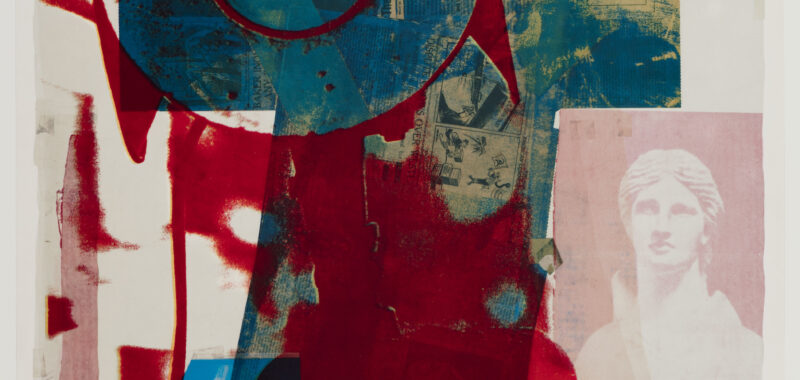SANTA BARBARA, Calif. — Autobiography: The title itself seems to suffer from delusions of grandeur. For a Robert Rauschenberg exhibition, it conjures entire museum floors choc-a-bloc with decades of art spanning Abstract Expressionism, Neo-Dada, and Postmodernism in nearly every medium imaginable.
Yet the exhibition, currently on view at the Santa Barbara Museum of Art, is comprised of only eight works, all photography and lithography. The word minuscule comes to mind, especially compared to blockbuster Rauschenberg retrospectives hosted by the likes of the Museum of Modern Art, Tate, and Centre Pompidou. But so does the word focus.
The show begins with the title work, an enormous triptych lithograph from 1968. The first panel features Rauschenberg’s astrological chart overlaid on his full-body X-ray, suggesting a cosmic intervention into the artist’s being by the unseen wheel of fate. The center panel is more intimate and overtly autobiographical, showing a photograph of the artist as a young child in a canoe with his parents, surrounded by spiraling text chronicling his life’s journey.

In the last panel, the New York City skyline intersects with a map of Rauschenberg’s birthplace of Port Arthur, Texas. Beyond this triangle of land in the upper left corner lies a topographic map of the Gulf of Mexico superimposed with a still from his choreographic work, Pelican. Garbed in a costume made from military cargo parachutes extended out on steel rods and gliding on white roller skates, Rauschenberg looks like a futuristic astronaut or a terrestrial angel trying to make sense of his position between the ethereal and the earthly.
Also among the eight artworks are two of Rauschenberg’s earliest photographs, “Quiet House–Black Mountain” (1949) and “Ceiling + Light Bulb” (1950), both taken at the generative Black Mountain College in North Carolina. In the first of these works, sunbeams stream through a high window onto a wooden chair at such an angle that both the shadow and shafts of light appear to curve. Conversely, the bulb in the second remains unlit, leaving viewers in the dark about what might exist if only one could tug the switch. Taken together, the works picture the tangible effect of light and its absence on our capacity to interpret the world around us.
Another notable work is “Quarry” (1968), an offset lithograph tracing the wayward imperial adventures of the United States through collected headlines, cartoons, and clippings positioned between two busts, one quintessentially Roman in style, the other American in a classic Colonial style. Here, the artist’s hand takes precedence over any imperial power, connecting the varied iconography into a limited-perspective landscape with blue strokes and pink washes, viewed through a bold red shape that can be read as a porthole, magnifying glass, or scope.

The show ends by looking to the past for a hopeful vision of the future. “For Ferraro” (1992) is an homage to the trailblazing stateswoman, environmentalist, and politician Geraldine Ferraro. In 1984, Ferraro became the first female vice-presidential nominee for a major party when she ran alongside Walter Mondale, having already made a name for herself, first as a tough litigator and then as a rising star in Congress. More hidden is the inferred changing of the guard as a new generation begins to reshape the ways that the past and future are defined.
In many ways, Autobiography is a self-explanatory exhibition — no complex wall texts are needed to make sense of its works. Yet this is its great strength. For an artist whose oeuvre may be fairly described as oceanic, such pinhole focus offers rare insight into his methods of making meaning and art. But, perhaps more importantly, it is an invitation for visitors, whether well acquainted with his art or not, to sit for a while with an artist who thought of himself above all as a humanist.



Robert Rauschenberg: Autobiography continues at the Santa Barbara Museum of Art (1130 State Street, Santa Barbara, California) through November 3. The exhibition was curated by Charles Wylie.

